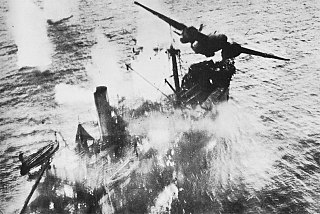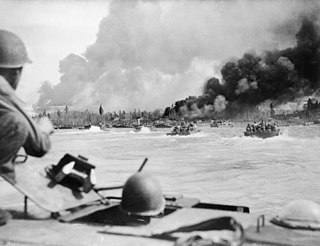South West Pacific theatre of World War II
Theatre of World War II From Wikipedia, the free encyclopedia
Theatre of World War II From Wikipedia, the free encyclopedia
The South West Pacific theatre, during World War II, was a major theatre of the war between the Allies and the Axis. It included the Philippines, the Dutch East Indies (except for Sumatra), Borneo, Australia and its mandate Territory of New Guinea (including the Bismarck Archipelago) and the western part of the Solomon Islands. This area was defined by the Allied powers' South West Pacific Area (SWPA) command.

In the South West Pacific theatre, Japanese forces fought primarily against the forces of the United States and Australia. The Philippines, New Zealand, the Netherlands (in the Dutch East Indies), United Kingdom, and other Allied nations also contributed forces.
The South Pacific became a major theatre of the war following the Japanese attack on Pearl Harbor in December 1941. Initially, US war plans called for a counteroffensive across the Central Pacific, but this was disrupted by the loss of battleships at Pearl Harbor. During the First South Pacific Campaign, US forces sought to establish a defensive perimeter against additional Japanese attacks. This was followed by the Second South Pacific Campaign, which began with the Battle of Guadalcanal.

The U.S. General Douglas MacArthur had been in command of the American forces in the Philippines in what was to become the South West Pacific theatre, but was then part of a larger theatre that encompassed the South West Pacific, the Southeast Asian mainland (including Indochina and Malaya) and the North of Australia, under the short lived American-British-Dutch-Australian Command (ABDACOM). Shortly after the collapse of ABDACOM, supreme command of the South West Pacific theatre passed to MacArthur who was appointed Supreme Commander, South West Pacific Area on 30 March 1942.[1][2] However, MacArthur preferred to use the title "Commander-in-Chief." The forces remaining in South-East Asia under Japanese attack reverted to their local commanders, and were soon mostly destroyed or evacuated.
The other major theatre in the Pacific, Pacific Ocean Areas, was commanded by U.S. Admiral Chester Nimitz, who was also Commander-in-Chief Pacific Fleet. Both MacArthur and Nimitz were overseen by the US Joint Chiefs and the British-U.S. Combined Chiefs of Staff. Captain Allan Rockwell McCann was appointed to represent the Navy as the Senior Representative of Commander, Submarines, Southwest Pacific, to General MacArthur.
Most Japanese forces in the theatre were part of the Southern Expeditionary Army (南方軍, Nanpo gun), which was formed on November 6, 1941, under General Hisaichi Terauchi (also known as Count Terauchi). The Nanpo gun was responsible for Imperial Japanese Army (IJA) ground and air units in Southeast Asia and the South Pacific. The Combined Fleet (聯合艦隊, Rengō Kantai) of the Imperial Japanese Navy (IJN) was responsible for all Japanese warships, naval aviation units and marine infantry units. As the Japanese military did not formally utilize joint/combined staff at the operational level, the command structures/geographical areas of operations of the Nanpo gun and Rengō Kantai overlapped each other and those of the Allies.




Seamless Wikipedia browsing. On steroids.
Every time you click a link to Wikipedia, Wiktionary or Wikiquote in your browser's search results, it will show the modern Wikiwand interface.
Wikiwand extension is a five stars, simple, with minimum permission required to keep your browsing private, safe and transparent.